Since the time of my last analysis, we have received 3 more chapters of mangaka Kōhei Horikoshi’s “My Hero Academia.” In these three chapters (numbered 149 through 151), it would appear as if we’re reaching the climax of the current story arc.
The Shie Hassaikai Director and source of the labyrinth, Joi ‘Mimic’ Irinaka, was dealt with – following the hasty retreat of Twice and Toga – by Deku, Eraserhead and Sir Nighteye. The majority of the Hassaikai’s Eight Bullets have even been neutralised, with the exception of Shin Nemoto (who is present but barely conscious) and the large, currently unnamed member whose fate is unknown after facing off against the Ryukyu hero agency by the front gate.
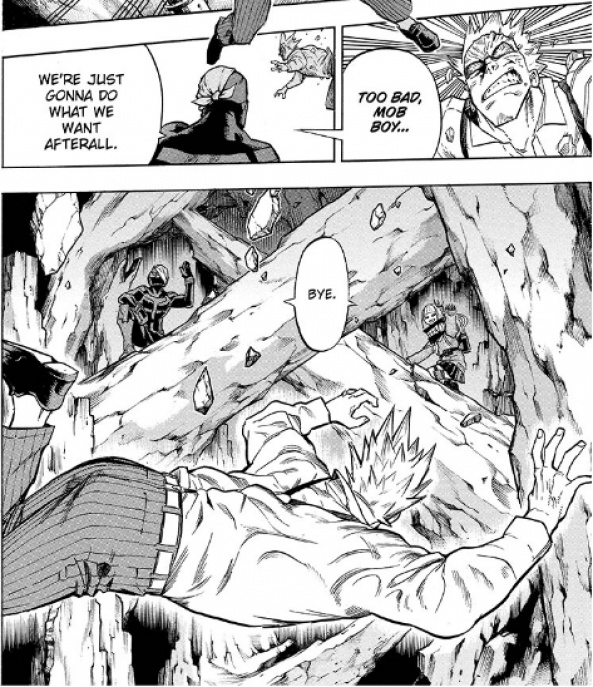
The most telling sign however, that the story is indeed reaching the end of the current arc, is the reappearance of Mirio ‘Lemillion’ Togata at the end of Chapter 149 (titled ‘Don’t Get Mad, Irinaka’). His confrontation with the young leader of the Hassaikai, Kai ‘Overhaul’ Chisaki, and his aide Chronostasis has been the subject of the two most recent chapters. Retrieving the young girl Eri, from the clutches of the Yakuza group, is the objective of the heroes’ infiltration of the Hassaikai compound after all. So Lemillion’s attempt to do exactly that is indicative of the arc’s supposed final stages.
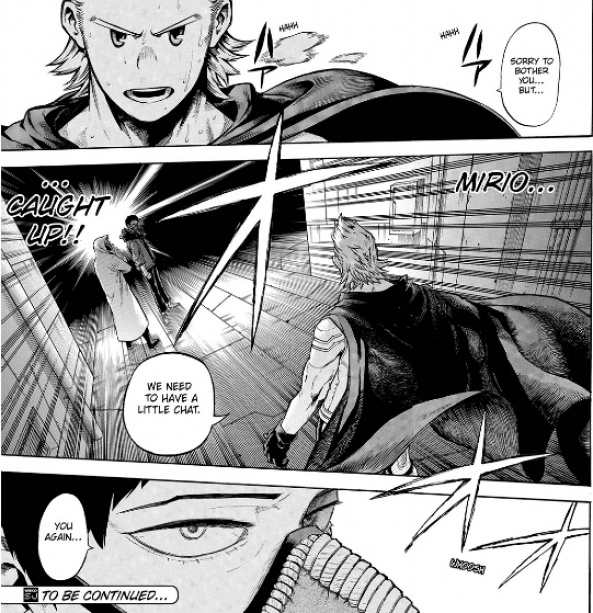
This particular conflict, although only having taken place for less than two chapters thus far, has been incredibly engaging and thrilling to see. Horikoshi has done well to create very realistic stakes for the characters involved, as the wellbeing of Eri, Lemillion and Lemillion’s quirk are undoubtedly in the balance. The difficult situation in which Lemillion finds himself is filled with genuine tension, and in no way feels forced or artificial. The threat that Overhaul poses after all, through either his devastating quirk or pragmatic demeanour, is a real one. As a result – despite Lemillion’s overwhelming talent and capability as a hero – both he and the readers know that any kind of mistake in Overhaul’s presence could lead to a gruesome end for the Big Three member.
While this aspect of the fight – in conjuncture with Horikoshi’s dynamic fight choreography and emphatic dialogue – has elevated its emotional impact in my eyes, there are a number of other aspects that have been included which I wish to highlight. The most interesting thing about these other narrative features though, is that I have already praised Horikoshi for making use of them in previous instalments of “Go Beyond.”
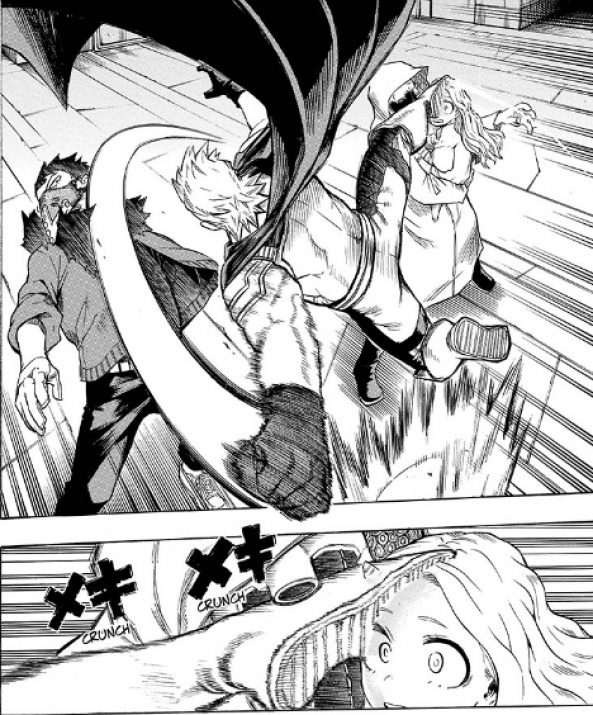
In my first analysis I touched upon Horikoshi’s growing confidence in his own ability to write engaging and enjoyable material, whilst managing to exclude the primary protagonist of the story. Given the current lack of Deku from the most recent conflict, and the sole focus being placed on Lemillion’s struggle instead, it would suggest that this trend might very well continue. And given the strength of the supporting cast in “My Hero Academia,” highlighted by the colour spread last month celebrating the series’ third anniversary, I can’t see why this wouldn’t continue to be well received on the whole.
In this same analysis I also brought up the clear parallels between Overhaul and Lemillion, both of which were introduced at a similar time. These characters were brought into the story, as a means of presenting a challenge to Tomura Shigaraki and Deku respectively. They were also both presented to the readers primarily through a show of force and skill, and so having these two particular characters oppose one another now makes for an intriguing and enthralling encounter.

The second analysis discussed the role of technology in a series such as this, which has the power to alter the abilities of the world’s inhabitants. While “My Hero Academia” has both power-boosting and power-eradicating materials, only the latter seems to be pivotal to the current skirmish. It is clear though that this narrative device, when handled in the way that Horikoshi has demonstrated, has the potential to elevate the intensity of the reading experience; as seen with Chapter 151 in particular.
Another topic that I highlighted in this piece was the ‘Next Tier Power-Up’ trope, commonly found in shōnen manga. While these recent chapters don’t necessarily allude to this specific narrative feature, clever writing has allowed for both powerhouses to appear more serious now than ever before by revealing different applications of their powers. Overhaul, for example, resorts to freely annihilating and restoring inanimate objects rather than specific enemies themselves; a feat we were yet to explicitly see him carry out. Lemillion though, despite having previously demonstrated a high level usage of his quirk, has now shown an even greater level of control. This was seen best in the most recent chapter, when Lemillion allowed his arm to pass through Overhaul’s hand – in order to land a solid hit to his opponent’s face – despite knowing that the young Hassaikai leader could kill him instantaneously with a single touch. This mixture of quirk mastery and tactical desperation, with either side willing to do anything and risk everything in order to secure a chance for victory, once again helps to elevate the stakes of the conflict to a palpable level.
Continued below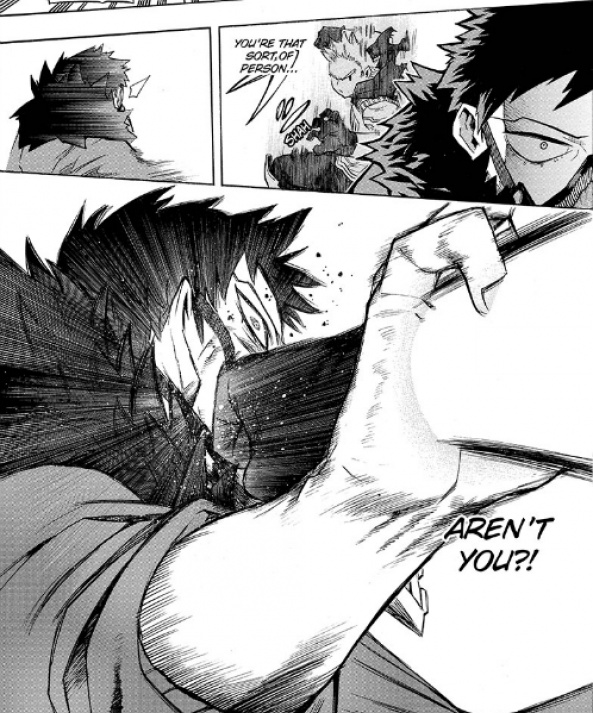
A subtler feature of this particular form of storytelling, raised in my third analysis of this series, is seen once again with Chapters 150 and 151. Horikoshi has been known to utilise chapter titles to convey emotion, particularly through his use of punctuation. Within this arc itself, as I have discussed prior to this piece, the use of exclamation marks in chapter titles have indicated a moment where the action escalates and a sense of urgency is felt. This distinction is made once again in the aforementioned chapters, as Horikoshi only alters the punctuation in the title. Both chapters are named ‘Mirio Togata,’ yet the latter has two exclamation marks signalling the heightened tensions experienced by the hero, and in turn by the readers. While Lemillion tangles with two of the Eight Bullets in Chapter 150 – Shin Nemoto and Deidoro Sakaki – he deals with the pair relatively easily. In Chapter 151 however, when Lemillion finally engages Overhaul, the task of emerging victorious is far more difficult and suspenseful.

This analysis also addresses Horikoshi’s take on inspiration within a superhero story. In doing so, I looked at the development Horikoshi gave to the connection linking Overhaul and a number of the Hassaikai’s Bullets. This relationship dynamic has been explored further in these chapters – and to an even more interesting degree – through the introduction of Shin Nemoto. Despite having a quirk with no physical capabilities, the ex-conman was willing to put himself on the front lines to defend his young master. Furthermore, despite receiving three hefty blows to his jaw at the hands of Lemillion, the Bullet crawled to his master’s aid. Both of these decisions show an unwavering dedication to his superior, and in turn serve to strengthen the depiction of Overhaul as an inspirational leader.
My fourth analysis discussed in depth the trope of ‘The Power of Friendship,’ and Horikoshi’s handling of such. This view was enhanced once more in these chapters, as Horikoshi showed willingness to not only demonstrate reliance among villains as a way of enhancing their combat effectiveness (ie. Setsuno, Hojo and Tabe), but also to ensure the wellbeing of their comrades regardless of position within an organisation (ie. Overhaul and Chronostasis).
Although Overhaul is quick to anger in a perilous situation, shown by him calling his aide a fool after losing Eri to Lemillion, he does not hesitate to save that same man from a certain knockout blow. This action demonstrates that Overhaul values his allies, which juxtaposes spectacularly with his own treatment of Eri. After all he speaks as if Eri was an object he owned rather than a comrade to the Shie Hassaikai, which in effect heightens the plight of the young girl, as witnessed by the reaction of Lemillion upon hearing such words. Before moving on, it must be noted that while Horikoshi’s depiction of raw emotion through facial expressions is normally a joy to behold, the work he has done with Lemillion in these chapters – despite having an almost comedically simple character design – is truly spectacular.
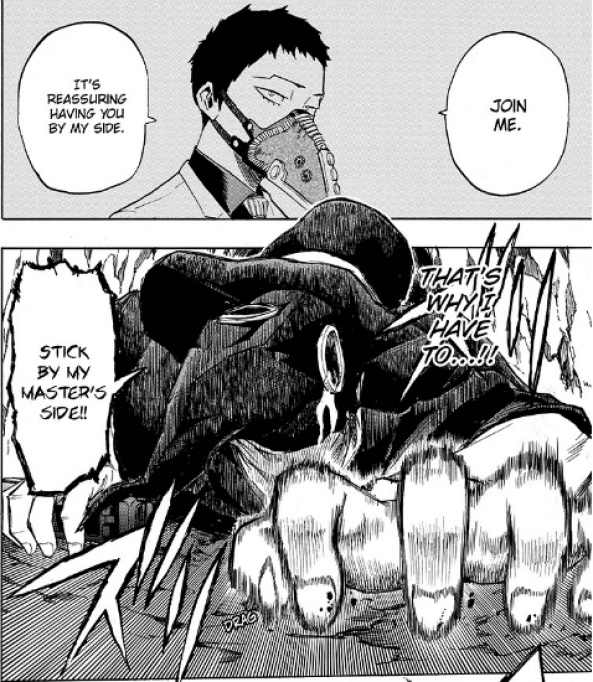
Meanwhile, in my most recent analysis, I discussed the application of flashbacks in shōnen manga. I argued that many use flashbacks to seemingly unlock untapped power in a character, with little to no foreshadowing, in order to write a character out of a corner. Horikoshi however has been known to use flashbacks as a way of clarifying either the intentions or actions of an individual, which is a far more nuanced way of having the past affect the present day. This can be seen once again, being handled masterfully, in the cases of Shin Nemoto and Overhaul.
Firstly, the relentless support that Nemoto provides Overhaul with is explained through a brief flashback. Centred on Nemoto’s issues with the utility of his quirk (‘Confession,’ which forces those around him to tell the truth when asked directly) in a real-life setting, it is revealed that all Nemoto ever wanted was someone he could trust. Given Overhaul’s usually frank personality it is made clear that Nemoto considers him to be this person, and as such he would do anything and everything to support him. Secondly, Overhaul’s flashback is used to give a little insight on his past with the organisation that once took him in. More importantly though, it helps to clarify just why he is quick to anger when referred to by the name Chisaki; as he himself proclaims that he has abandoned that name, whilst instead adopting the villain name Overhaul.
Continued belowWith all of this in mind, it is clear to me that this confrontation between Overhaul and Lemillion is an amalgamation of all the highly positive aspects of Horikoshi’s writing, which have been visible over the past few months. It looks to be a suitably gripping yet satisfying conclusion to an arc that may have indeed indicated a shift in the level of Horikoshi’s storytelling. While the pacing and structure of the story prior to the incident at Kamino Ward was brisk and refreshing in the realm of shōnen manga, the formula of the narrative no doubt required tweaking as the number of chapters slowly climbed.
The cyclical nature of showing a school event, followed by a villain invasion or chance encounter, could not persist forever without ultimately growing stale. At some point the heroes in training would have to (legally) take the fight to any and all evildoers out there, and what better time to implement this shift than following All Might’s retirement, given the seismic effect that event had on the wider world of “My Hero Academia.” What is key though, is that Horikoshi is now able to engage in the telling of story arcs of varying length and complexity.
As such, I’m very excited to see just exactly where Horikoshi intends to take both this arc and the story as a whole. There are many paths for him to explore after all, in the world of infinite possibilities that he has managed to craft with this particular series. What I am positive about however is that the quality will remain. I hope you’ll all indeed join me next month, to see just exactly where we’ll be led next in the wonderful world of “My Hero Academia.”






